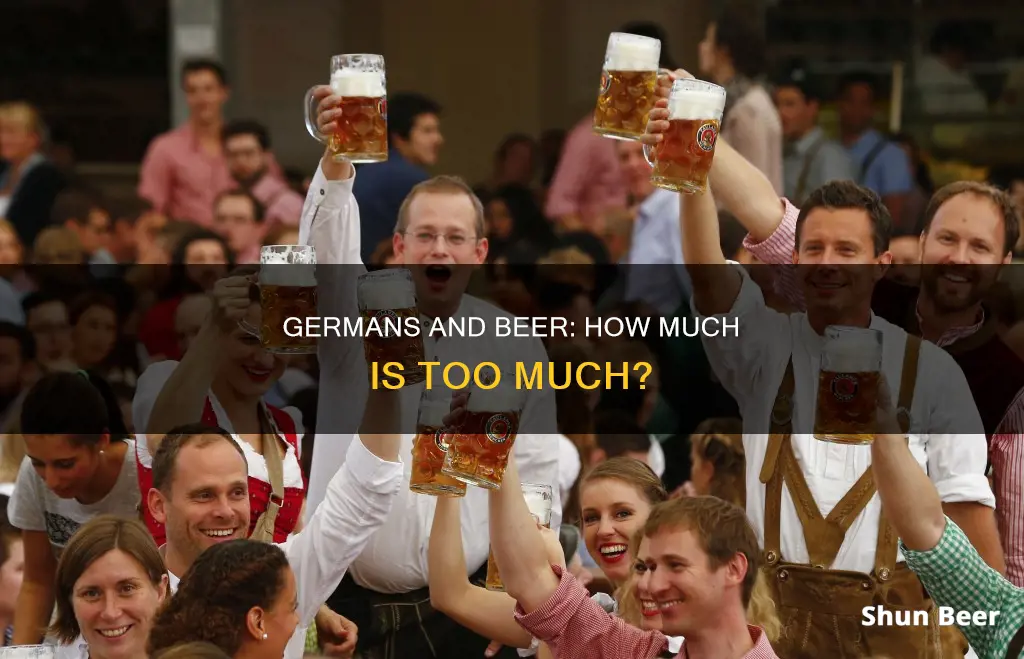
Germany is known for its beer, with over 1,500 breweries producing around 5,000 types of beer. The country ranks third in Europe for per-capita beer consumption. Beer is drunk at various times of day in Germany, generally with meals or alongside pretzels.
The German beer scene was traditionally centred on lagers, which were stored in cool caves before the invention of electricity. Today, almost any style of beer is available in Germany, from lagers to wheat beers, and from dark beers to alcohol-free options.
The country's beer-making process is governed by a food purity law, passed in 1516 by Duke William IV of Bavaria, which states that only barley, malt, hops and water are allowed in beer production.
So, how much beer do Germans drink? Well, it's hard to say exactly, but with a rich history of brewing and a wide variety of beers available, it's clear that Germans do indeed drink a lot of beer.
| Characteristics | Values |
|---|---|
| Number of breweries | 1,300 |
| Number of beer types | 5,000-7,000 |
| Beer consumption rank in Europe | 3rd |
| Beer consumption in litres per capita | 101.2 |
| Beer consumption in litres in total | 8.2 billion |
| Beer consumption in bottles in total | 10.7 billion |
| Beer consumption in non-alcoholic beer in litres | 556 million |
What You'll Learn

German beer purity law
The German Beer Purity Law
The German Beer Purity Law, or Reinheitsgebot, is the oldest food safety law still in existence. The law was established in 1516 by Bavarian Duke Wilhelm IV and limits the ingredients in beer production to water, barley and hops. The role of yeast in the brewing process was not understood at the time, but it was later accepted as an ingredient, as was wheat, which was initially reserved for baking bread.
The law was enacted to prevent unscrupulous brewers from using unsavoury and dangerous additives in beer, which was considered a basic foodstuff. It also served to ensure the availability of affordable bread by reserving wheat and rye for bakers. The rule may have had a protectionist role, as beers from Northern Germany often contained additives that could not be grown in Bavaria. Religious conservatism may have also played a part, as the law helped suppress the use of plants used in pagan rituals.
The law was initially only applied in the Duchy of Bavaria but, as Germany unified, Bavaria pushed for its adoption on a national basis. It was not until 1906 that the law was applied consistently across all of Germany.
The German Beer Purity Law remains influential in brewing, both in Germany and around the world. All traditional German beers are brewed within the law, though some exceptions are made for regionally historic styles. German brewers have also used the law to market German beer internationally.
In late 2015, Bavarian brewers voted in favour of revising the law to allow other natural ingredients. However, many brewers still follow the original 1516 purity law as it is considered part of the national identity.
Is Casual Drinking Really Casual?
You may want to see also

German beer consumption
Germany is known for its beer, with over 1,500 breweries churning out 5,000 types of beer. The country ranks third in Europe for per-capita beer consumption.
The German beer scene traditionally centred on lagers, which were stored in cool caves before electricity. Today, almost any style of beer is available throughout Germany. The more common varieties include lagers, specifically Märzen lagers (think Oktoberfest beers). These are usually amber in colour and exhibit little to no hop aroma or flavour, instead showcase malt flavours of toast or bread crust. German Pils are also common. The German interpretation of pilsners often emphasises hop character and is clean, crisp, and refreshing.
Other varieties of German beer include:
- Helles or Dunkles Lager: This bottom-fermented beer has more pronounced malt notes and comes in light or dark colour, depending on the degree to which the malt was roasted. It is less bitter and usually has about 4.5% alcohol. Well-known brands include Löwenbräu, Hofbräu, and Dortmunder Aktienbrau (DAB).
- Export lager: This is a bottom-fermented beer like Helles, but with a higher alcohol content of over 5%. Well-known brands include Dortmund and Munich Export beers, and Beck’s Beer from Bremen.
- Kölsch and Alt: These beers are intimately connected to the cities on the Rhine river – Köln/Cologne (Kölsch) and Düsseldorf (Alt). They are top-fermented, with a balanced flavour, 4.8% alcohol, and a smooth finish. They are served in cylindrical, narrow glasses and downed in minutes. Kölsch is made from light malt, while Altbier is made from darker roasted malt, making it a bit more bitter.
- Weißbier (Wheat Beer): Kristall, Hefe, and Dark: This top-fermented beer has 5-5.8% alcohol and a refreshing, zesty flavour. It is served in tall slender glasses, as the malt is part barley, part wheat. Pouring a Weißbier from a bottle is tricky – the glass must first be dipped in water, then tilted as far as possible to slowly “pull” the suds from the bottom to the top. Otherwise, the beer will overflow with foam. Weissbier comes in Kristall (clear colour, filtered), Hefe (cloudy, yellow colour, with some wheat and yeast residues), and Dunkel (roasted dark malt).
- Starkbier or Bockbier: This full-bodied beer is a Southern German favourite, traditionally brewed in March for consumption during Lent. It has a minimum of 16% wort and about 7%+ alcohol content. The colour ranges from golden to very dark.
- Berliner Weisse – Red or Green: This is a refreshing, fruity, wheat beer that originated about 300 years ago in Berlin. It has about 7% wort and only 2.4% alcohol content. It is fermented with a mix of brewers' yeast and lactic acid bacteria, giving it a lightly tart, crisp flavour. It is typically sweetened with raspberry (red) or woodruff (green) extract.
- Märzen or Oktoberfestbier: This bottom-fermented beer is similar to Helles, but with a minimum of 13% wort and 4.8-5.6% alcohol content. It is traditionally brewed in March and served during the famous Munich Oktoberfest. With soft malty notes, Märzen is pleasant to drink and is typically consumed in steins in beer halls.
- Gose: A specialty wheat beer originating in the city of Goslar near the Harz Mountains. Like Berliner Weisse, this top-fermented beer is fermented with yeast and lactic acid bacteria, giving it a lightly sour note. Salt and coriander are added during the brewing process.
- Rauchbier (Smoked Beer): This amber to dark-coloured, bottom-fermented beer is made by infusing beechwood smoke during the malting of barley. It has a wort and alcohol content similar to Schwarzbier or light Bockbier.
- Radler or Alsterwasser: This is not a separate beer category, but rather lager beer mixed with lemon soda. Known as Radler below the Danube and Alsterwasser north of the Danube, this mix contains less alcohol than Helles and is less bitter. It is enjoyed at many pubs and beer gardens, especially in Munich, Cologne, and Hamburg.
In recent years, there has been a trend towards non-alcoholic beer in Germany, with the volume of non-alcoholic beers doubling between 2013 and 2023.
Beer After Working Out: Good or Bad Idea?
You may want to see also

German beer brands
Germany is home to over 1,500 breweries, producing around 5,000 types of beer. Germans are known for their love of beer, and with so many varieties to choose from, it's no surprise that beer consumption is a significant part of the culture. While many Germans grow up drinking local beers and remain loyal to those brands, there are also well-known German beer brands that are popular across the country and even internationally. Here are some of the top German beer brands:
Bitburger:
Bitburger was founded in 1817 in the city of Bitburg, from which it takes its name. Their flagship product is the Bitburger Premium Pils, a crisp, pale golden lager with a clean flavour. They also offer an unfiltered version, as well as an alcohol-free option. Bitburger is one of the most dominant brands in the German beer market and is the nation's leading draft beer.
Köstritzer:
Köstritzer is one of Germany's oldest beer brands, dating back to 1543. They specialise in Schwarzbier, or black beer, which is known for its distinctive roasted malt character. In addition to their signature Schwarzbier, Köstritzer also offers a range of other brews, including Kranich-Bräu, Edel-Pils, and even a beer-cola mix called Bibop.
Wernesgrüner:
This brand has a long history, dating back to 1436, and is known for its Pilsner, a bitter specialty that gained popularity during the communist era in East Germany. Wernesgrüner follows the Reinheitsgebot law, allowing only malt, hops, yeast, and water as ingredients, and is considered a premium beer brand, especially in the former East Germany region.
Erdinger:
Erdinger is the world's largest wheat beer brewery, founded in 1886. They offer a diverse range of wheat beers, including their flagship Weißbier, as well as Dunkel, Kristallweizen, and Pikantus. Erdinger also has a unique marketing strategy, positioning their Alkoholfrei beer as a post-workout sports drink due to its isotonic qualities.
Franziskaner:
With a history dating back to 1363, Franziskaner is known for its wheat beers, particularly the Franziskaner Hefe-Weißbier, a hazy, golden brew with a hint of fruity goodness. They also brew a dark wheat beer, Dunkelweizen, and a crystal-clear option, Kristallweizen. Franziskaner is unique in that they use open fermentation tanks, giving their beer an unmistakable character.
Diebels:
Diebels was established in 1878 and is known for its Altbier, a top-fermented brew that follows the German Beer Purity Law of 1516. They were one of the first breweries to produce Altbier and quickly gained a significant market share. In addition to their Altbier, Diebels also offers a Pilsner-style beer.
Spaten:
Spaten is one of Bavaria's largest breweries, producing around 2.4 million hectoliters of beer annually. Their Spaten Münchner Hell is a pale lager with a subtle blend of malt and noble hops, rounded out with delicate citrus and fruity notes. They also brew a seasonal beer, Spaten Oktoberfestbier, specifically for Munich's iconic Oktoberfest celebration.
Beck's:
Founded in 1873, Beck's is a well-known German beer brand, now operating under the Anheuser-Busch InBev conglomerate. Their superstar is Beck's Pilsner, a classic German-style pilsner with a 5% ABV. They also offer Beck's Gold, a premium beer with a unique blend of hops and barley malt, and Beck's Blue, a crisp and clean alcohol-free option.
Schöfferhofer:
Established in 1806, Schöfferhofer is known for its wheat beers, particularly the Schöfferhofer Hefeweizen. However, they gained fame for being the first to blend wheat beer with grapefruit juice, creating the popular Schöfferhofer Grapefruit. They have since expanded their fruity offerings with Schöfferhofer Pomegranate.
Löwenbräu:
With a history dating back to 1383, Löwenbräu is a German beer brand recognised for its iconic lion symbol. Their flagship product, Löwenbräu Original, is a classic German-style lager with a 5.2% ABV. They also offer Löwenbräu Gold, a premium brew, and Löwenbräu Radler, which blends beer with lemon soda for a unique, refreshing taste.
These are just a few of the many renowned German beer brands that have gained popularity both within Germany and internationally. Each brand has its own unique history, brewing techniques, and range of beer styles, contributing to the diverse and vibrant German beer culture.
Testosterone and Beer: Is It Safe to Drink Alcohol?
You may want to see also

German beer styles
Lager
The mighty lager has found a place in both Michelin-starred restaurants and home garages worldwide. Lagers include the full-yet-refreshing helles, the rich and smoky rauchbier, the fruity hefeweizen, and the crisp kölsch.
Helles
Helles is a German take on the pilsner, developed in Munich in the 1890s. It is a pale lager that is a bit fuller and sweeter than a pilsner, with notes of hay, biscuit, honey, fresh-cut grass, and toasted bread.
Pilsner
Pilsner is Germany's most consumed beer category and the basis of many American lagers. It is a pale to golden lager with a crisp, floral aroma and a zesty, bitter mouthfeel.
Rauchbier
Rauchbier, or "smoke beer", is a style of German lager that uses malt smoked over beechwood, giving it a unique smoky flavour. It is produced in Bamberg, Bavaria, and is an unusual, savory beer.
Hefeweizen
Hefeweizen is a type of wheat beer and is one of Germany's most famous ales. It is cloudy and has a powerful banana and clove-like aroma due to its high yeast content.
Dunkelweizen
Dunkelweizen is a darker variation of hefeweizen with a caramelly, dark fruit-like flavour, sometimes likened to liquid banana bread.
Weizenbock
Weizenbock is a stronger version of hefeweizen and dunkelweizen, with a higher ABV and more flavour.
Kölsch
Kölsch is a light and crisp wheat beer native to Cologne. It has a delicate, mildly fruity flavour with a relatively assertive hop profile and a mellow pale malt presence.
Berliner Weisse
Berliner Weisse is a tart wheat beer soured through fermentation with Lactobacillus bacteria. It is low in ABV and often served with a splash of sweet fruit syrup to cut the bitterness.
Gose
Gose is another wheat beer that is soured with Lactobacillus, but it also contains salt and coriander, giving it a citrusy, lightly spiced essence and a crisp mouthfeel.
Bock
Bock is a strong, very malty lager with a toasty, bready, slightly sweet flavour. It typically has an ABV of 6-7%.
Doppelbock
Doppelbock is a stronger, maltier version of bock, with a higher ABV and a rich, caramelised sugar flavour. It often has chocolatey and dark fruit notes.
Eisbock
Eisbock is an even stronger version of doppelbock, with a portion of the water content removed through freezing, resulting in a boozy, concentrated beer with an ABV of 9-14%.
Märzen/Oktoberfest Beer
Märzen, also known as Oktoberfest Beer, is a copper-coloured, mildly hoppy, and toasty lager. It is traditionally brewed in March and consumed at Oktoberfest celebrations.
Schwarzbier
Schwarzbier, or "black beer", is the darkest of all German lagers. Despite its appearance, it has a lighter flavour profile than other dark beers, with notes of chocolate and a lightly bready malt character.
Ear Piercing and Beer: What's Safe?
You may want to see also

German beer history
Germany has a long and proud history of brewing beer, with over 1,500 breweries churning out 5,000 different types of beer. The country ranks third in Europe for per-capita beer consumption.
The German Beer Purity Law, passed in 1516 by Duke William IV of Bavaria, is perhaps Europe's first food purity law and is still in force today. It states that only barley, malt, hops, and water are allowed in the beer-making process, revolutionizing an industry rife with the adulteration of foodstuffs.
- Pilsner: A relatively new addition to the beer scene, created in 1842 by German brewmaster Josef Groll in the town of Pilsen, Bohemia (now in the Czech Republic). Pilsner is bottom-fermented, light-colored, and has a distinct bitter and 'hoppy' note and aroma. Popular brands include Krombacher, Warsteiner, Bitburger, and Radeberger.
- Helles or Dunkles Lager: This bottom-fermented beer has more pronounced malt notes and comes in light or dark colors depending on the degree of malt roasting. It is less bitter, with an alcohol content of around 4.5%. Well-known brands include Löwenbräu, Hofbräu, and Dortmunder Aktienbrau (DAB).
- Export Lager: Similar to Helles, but with a higher alcohol content of over 5%. The most globally recognized brand is Beck's Beer from Bremen, founded in 1876.
- Kölsch and Alt: These beers are intimately connected to the cities of Cologne and Düsseldorf, respectively. They are top-fermented with a balanced flavor, 4.8% alcohol content, and a smooth finish. Kölsch is made from light malt, while Altbier is made from darker roasted malt, giving it a slightly more bitter taste. They are typically served in narrow, cylindrical glasses and are meant to be consumed quickly.
- Weißbier (Wheat Beer): Consumed primarily in Southern Germany, this top-fermented beer has an alcohol content of 5-5.8% and a refreshing, zesty flavor. It is served in tall, slender glasses and can be found in three varieties: Kristall (clear and filtered), Hefe (cloudy and yellow with some wheat and yeast residues), and Dunkel (roasted dark malt).
- Starkbier or Bockbier: A full-bodied, Southern German favorite, traditionally brewed in March for consumption during Lent. It has a minimum of 16% wort and an alcohol content of 7% or more.
- Schwarzbier: Germany's equivalent of Guinness, primarily consumed in Thuringia and Saxony. It is bottom-fermented, full-bodied, lightly sweet, and malty, with an alcohol content of around 4.8%. Köstritzer Schwarzbier is a famous brand.
- Berliner Weisse: A refreshing, fruity wheat beer that originated in Berlin about 300 years ago. It has a low alcohol content of 2.4% and is fermented with a mix of brewers' yeast and lactic acid bacteria, giving it a lightly tart, crisp flavor. It is typically sweetened with raspberry (red) or woodruff (green) extract.
- Märzen or Oktoberfestbier: Similar to Helles but with a higher wort content and alcohol content, ranging from 4.8% to 5.6%. It is traditionally brewed in March and consumed during the famous Munich Oktoberfest.
- Gose: A specialty wheat beer originating in the city of Goslar, similar to Berliner Weisse in that it is fermented with yeast and lactic acid bacteria, giving it a lightly sour note. Salt and coriander are added during the brewing process.
- Rauchbier (Smoked Beer): Infused with beechwood smoke during the malting of barley, this beer is amber to dark in color, bottom-fermented, and has a similar wort and alcohol content to Schwarzbier or light Bockbier.
- Radler or Alsterwasser: Lager beer mixed with lemon soda, known as Radler below the Danube and Alsterwasser north of the Danube. It contains less alcohol than Helles and is enjoyed in pubs and beer gardens, particularly in Munich, Cologne, and Hamburg.
In addition to these styles, Germany also has a growing market for non-alcoholic beers, with most breweries now offering their own versions.
Light Beers: A Year-Round Refreshing Choice?
You may want to see also
Frequently asked questions
On average, Germans drank 95 litres of beer in 2020 and 88 litres in 2023.
Germany is one of the high-consumption countries internationally, ranking fourth in the world in pure alcohol consumption per capita, behind only Moldova, Lithuania and the Czech Republic.
According to a 2020 study, Germans drank on average 131.3 litres of alcoholic beverages in 2018.
A 2022 study found that 52% of Germans drank German beer, 26% drank both national and imported beers, and 22% drank imported beer.
Beer consumption in Germany has been falling consistently since 1990, possibly due to a growing selection of other beverages, prices, and lifestyle and health choices.







